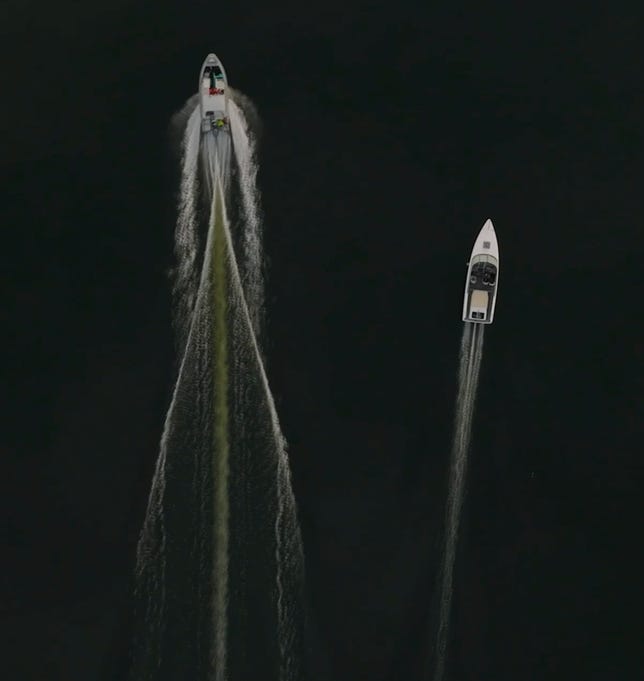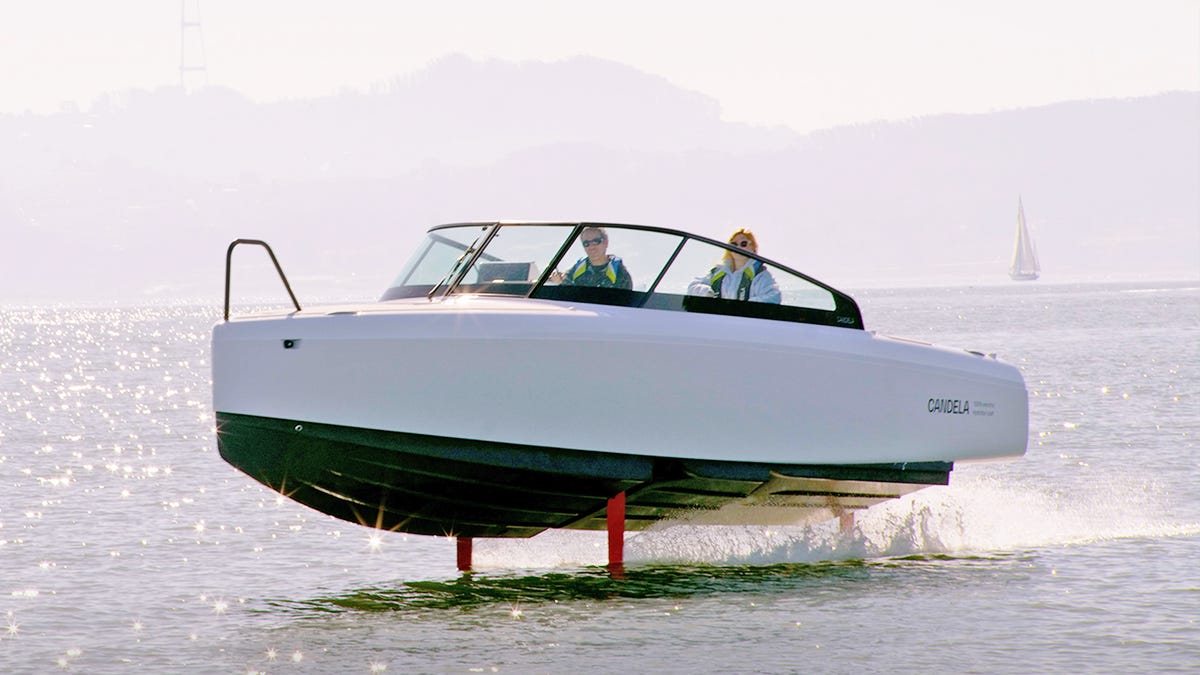There's something incredibly surreal about being in a high-powered vehicle worth almost half a million dollars, and not even realizing it's turned on. But my first ride in the Candela C-8 hydrofoil speedboat was so impressive that, at first, I didn't even realize it had begun.
I'm on the water in Sausalito, on the edge of the beautiful San Francisco Bay, about to take my first "test flight" in Candela's all-electric leisure craft -- a 28-foot power boat that uses hydrofoils to float out of the water and "fly" above the waves. After working on the carbon-fiber boat for more than two years with a team of 50 engineers, the Swedish company has brought the C-8 to California in a bid to break in to the massive boating market in the US. Based on the impressive boats I see at the dock in Sausalito, this seems like a good place to start.

Sorry, Leonardo DiCaprio -- now I know what it really feels like to be flying on a boat.
CelsBut though the 100% carbon-fiber hull, sleek design and $390,000 price tag might set the C-8 apart as a luxury craft for the well heeled, this boat is more than just an expensive toy. With the design of the C-8, Candela set out to solve one of the biggest problems in boating: inefficiency.
While companies like Tesla are trying to overhaul the car market by doing away with combustion engines in favor of battery power, the world of boating is arguably in need of a bigger fix.
According to Candela, a traditional planing-hull boat uses about 15 times as much fuel per mile as a family car. An outboard motor sputtering through gas or diesel fuel at the back of a boat is noisy, the emissions are significant, and the motors require regular servicing. All because a boat is trying to push its way through water, which constantly resists it.

An aerial shot showing the wake created by a traditional power boat and the wake generated by the C-8.
CandelaCandela has overhauled the traditional speedboat design, replacing the combustion motor with a 69kWh Polestar battery and a comparatively small, torpedo-shaped direct drive motor (known as the C-Pod) that stays completely underwater, affixed to the boat's rear hydrofoil. That motor and the C-8's hydrofoils are the boat's secret weapon.
When Candela CEO Tanguy de Lamotte unplugs the boat from the charger and starts the ignition, I don't hear a thing. As we move away from the dock, I still can't hear it. As we cruise out to the bay, and I sit on the back of the boat having a perfectly audible whispered conversation with my colleague John Kim, all I can really hear is the sound of water lapping at the carbon-fiber hull, and a quiet, dull whir.
But when we finally get out into the bay, where we can get to higher speeds, that's when I realize the power this motor brings.
"The idea is it's like a plane," de Lamotte tells me as he pushes up the throttle. "You go straight and full power and then it will take off."
With that, I hear the motor kick in and we push through the water and begin to rise out of the bay. Within a few seconds, we're above the water, soaring up on the hydrofoils and cruising at 22 knots (or roughly 25 mph).
"Now we are flying!" de Lamotte says.

When it's out of the water in hydrofoiling mode, the C-8 creates a thin wake.
CandelaThanks to the hydrofoil design, the C-8 uses roughly the same amount of power when it's foiling at this speed as it did when we were coming out of the marina at a speed of 5 knots -- about 1.2 kilowatt hours per nautical mile in both cases. "That's how efficient the foils are," de Lamotte tells me.
The boat has a range of about 57 nautical miles (66 miles) at the 22-knot cruising speed, and it can reach up to 27 knots at top speed. On our ride, we spent about two hours on the water, most of that at cruising speed, and we returned to the marina with 30 percent battery.
But it isn't just about efficiency. The feeling when we're foiling is unbelievably smooth. As we soar toward the Golden Gate Bridge, there's no large wake trailing behind us, and we're not bouncing up and slamming down on the waves. It feels like the boat is on a camera gimbal.
While we're on the C-8, I look over at the chase boat where my colleague Celso Bulgatti is filming us from afar. The outboard motors are roaring away and the boat is speeding alongside us, bouncing up and down on the white water and getting air as it cruises over ferry wakes. (Thankfully, Celso is like a walking camera gimbal himself, and the footage he shot that day is flawless -- what a pro.)
The hydrofoils use basic laws of physics that are as old as nature. Essentially, the water moves over the top and bottom of the airplane-wing-shaped foil at different speeds, creating a pressure differential that generates lift. But the tech inside the boat is cutting-edge.
The shape of the hydrofoil works similar to an airplane wing, generating lift in the water.
CandelaCandela has designed the carbon fiber layers in the foils so that they're more flexible in the middle, meaning the foils can twist and adjust in the water. Data from sensors, gyroscopes and accelerometers across the boat measure its movement in the water and the way the foils are performing. This data is then fed into the boat's flight controller, which makes constant adjustments to help the C-8 stay stable, kind of like avionics in a drone.
For de Lamotte, who's a veteran hydrofoil sailor and yacht designer who's sailed solo around the world, this hydrofoil experience is unique.
"In my career as a professional sailor we used foils as well, but we aren't allowed to have software to help us control the foil, so it's very different," he said. "But on this boat we're using electricity and the battery, and super high-tech software that adjusts the foils more than 100 times a second. And that's why anybody can do it."
And just like that, it's time to put that theory to the test. De Lamotte jumps out of the captain's seat and tells me it's my turn to take off.

"Road testing" the C-8 on the San Francisco Bay.
Celso Bulgatti/CNETThe last time I was in a speedboat, it was a little tin dinghy puttering across Womboyn Lake in Australia. By comparison, this feels like the Millennium Falcon.
But with the push of the throttle, I'm on my way, soaring out of the water and rising up on the hydrofoils. It feels as close as possible to flying, without actually getting in a plane. And it's far easier than driving a car.
To be sure, it's also far more expensive than a car (and not even something I could justify as a way to get to work in the morning, unless I were planning on commuting to a home office on Alcatraz). But it's quiet, it's smooth, and there aren't any gas emissions trailing out behind us. If this is the future of water travel, I'm totally on board.
"electric" - Google News
February 19, 2023 at 08:00PM
https://ift.tt/IpLEcs7
'Flying' on the Water: Testing Candela's Electric Hydrofoil Power Boat - CNET
"electric" - Google News
https://ift.tt/aGTtKLr
https://ift.tt/O2ysWjc
Bagikan Berita Ini















0 Response to "'Flying' on the Water: Testing Candela's Electric Hydrofoil Power Boat - CNET"
Post a Comment